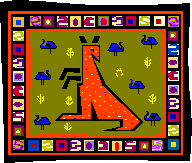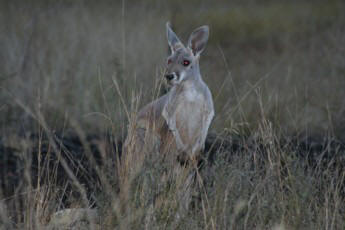NUTRITION & ADAPTATION
Red Kangaroos are herbivores, meaning that they rely solely on plants for their nutritional needs. When selecting plants to eat, they generally choose grasses, plants, and shrubbery with high water content. This species generally forages for food at night when the temperatures are much cooler to avoid the sweltering daylight sun. By moving at night, it is easier for the kangaroo to conserve valuable energy and water.
Red Kangaroos have a digestive system that is highly specific to their diet. It is similar to those of sheep and North American deer. Kangaroo's teeth are specialized for chewing tough plants and grasses. They have front incisors that cut the food and back molars that help grind it into a paste. By eating tough vegetation, kangaroo teeth get worn down over time. Unlike placental mammals that usually lose and then grow new ones to replace them, teeth in kangaroos move forward and are shed out of the mouth. Eventually, the kangaroo is left with only its back molars. After the food is chewed and swallowed it is carried down the esophagus into the gut. It is in the expanded foregut where bacteria, fungi, and protozoa are able to ferment food that the animal is unable to do with its own digestive enzymes. Because there is no oxygen in this portion of the gut, all energy from the food can be conserved. This also enable the microorganisms to utilize only a small amount of the energy from the food, therefore leaving the rest for the kangaroo. This mutualistic relationship has allowed the kangaroo to survive by eating vegetation that does not provide a great deal of energy. When digestion is finished, the kangaroo usually gains about 70% of the energy ingested, which is considerably higher than other herbivores, but still lower than most carnivores. Nutrients are then carried in the blood throughout its closed circulatory system to provide nutrition to the systemic tissues of the body. If extra energy is consumed, it is stored in tissues of the body.
Interestingly, the Red Kangaroo can survive by drinking water only twice a week. It is able to do this because of its efficiency in utilizing water found in the foliage it eats each day. During the cooler months of the year the Red Kangaroo can survive solely on the vegetation it feeds on for its water needs. Not only is this species extremely efficient in its lifestyle and water consumption, it also has the ability to excrete salts that are concentrated in the urine to decrease its water loss. Also, by reabsorbing urea, the waste product in urine, the body can reuse this substance and ultimately help conserve water. The elongated structure of the Red Kangaroo's large intestine and rectum also function to produce a dry feces, insinuating further water reabsorption in the last stages of digestion.
The Red Kangaroo has adapted in a variety of ways to help cool itself during the day. One way is by using saliva as a cooling agent. On hot days, the kangaroo will give itself a "saliva bath" and lick its entire body. When the saliva evaporates off the fur it takes the heat with it, therefore decreasing the relative body temperature of the kangaroo. It is comparable to the sweating that humans do when core body temperature increases. Red Kangaroos also use panting to as a way of dissipating heat. When panting they keep their mouths closed and adjust the amount of evaporation by changing the amount of airflow through their nostrils. The final method of heat dissipation is by sweating, but this usually only occurs when they are in locomotion. This works by the same method as licking in that the evaporation of the fluid helps decrease the core body temperature. Of these three methods, the most commonly used and efficient is panting because it does not rely as highly on water for evaporation.
Another adaptation that has made that Red Kangaroo famous is its method of locomotion. The Red Kangaroo is one of limited species that utilize hopping as its method of transportation. It is interesting that besides wallabies, no other large mammals have this adaptation. This indicates that the body structure and shape have also been highly specialized. Traditionally the Red Kangaroo's hopping style is described as having a flat back that is in line with a low head. The tail remains fairly straight and swings less than other kangaroo species. Scientific studies have shown that hopping has a variety of advantages. Quadruped, placental animals have increased metabolic needs when they increase the speed at which they move. Surprisingly, the Red Kangaroo only uses a great amount of energy to initiate hopping, after this point, metabolic needs decrease and it seems as though the faster the hop, the more efficient they become. This phenomenon can be credited to the very strong elastic tissue found in the tendons of the kangaroo that help store energy. It is similar to a pogo stick: the harder and faster you land, the higher and farther you jump. When it comes to reacting to stimuli, the Red Kangaroo have good eyesight although they are only able to react to moving stimuli. They are also able to move their heads very far for both visual and auditory purposes.


